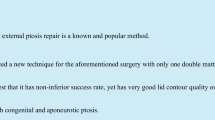Abstract
Background
The classical levator resection (LR) technique for correcting ptosis involves separating the levator palpebrae superioris muscle (LPS) completely, which will inevitably collapse the muscle. The modified surgical method involving retention of the LPS suspensory system can allow for more contractility of the levator muscle and thus maximize protection of the eyelid structure.
Methods
Ninety patients (132 eyelids) with different degrees of ptosis were enrolled. The same levator resection surgery whereby the suspensory system of the LPS is retained was performed in each patient. Postoperative outcome measures included the following: position of the upper eyelid margin, eyelid contour and plumpness, degree of scleral exposure, and exposure keratitis. Postoperative follow-up time points were 1 week, 1 month, and 6 months.
Results
The positions of the eyelid upper margins were normal in all cases, and lagophthalmos only existed in severe cases in the early stage after surgery. Six months after surgery, 32% of the eyes had residual ptosis to varying degrees among severe cases, and the mild and moderate cases exhibited good surgical outcomes. The eyelids had appropriate closing functionality, and exposure keratitis was not observed in any case. Eyelid contour and plumpness was satisfactory in all patients.
Conclusion
Retaining the suspensory system of the LPS for LR with a modified surgery can protect the normal function and morphology of the eyelids. The surgery had a high success rate, especially for cases of mild and moderate ptosis.
Level of Evidence IV
This journal requires that authors assign a level of evidence to each article. For a full description of these Evidence-Based Medicine ratings, please refer to the Table of Contents or the online Instructions to Authors www.springer.com/00266.




Similar content being viewed by others
References
Finsterer J (2003) Ptosis: causes, presentation, and management. Aesthetic Plast Surg 27(3):193–204
SooHoo JR, Davies BW, Allard FD et al (2014) Congenital ptosis. Surv Ophthalmol 59(5):483–492
Baroody M, Holds JB, Vick VL (2005) Advances in the diagnosis and treatment of ptosis. Curr Opin Ophthalmol 16(6):351–355
Anderson RL (1985) Age of aponeurotic awareness. Ophthal Plast Reconstr Surg 1(1):77–79
Anderson RL, Jordan DR, Dutton JJ (1990) Whitnall’s sling for poor function ptosis. Arch Ophthalmol 108(11):1628–1632
Anderson RL, Dixon RS (1979) The role of Whitnall’s ligament in ptosis surgery. Arch Ophthalmol 97(4):705–707
Ettl A, Priglinger S, Kramer J et al (1996) Functional anatomy of the levator palpebrae superioris muscle and its connective tissue system. Br J Ophthalmol 80(8):702–707
Cruz AA, Akaishi PM, Mendonca AK et al (2014) Supramaximal levator resection for unilateral congenital ptosis: cosmetic and functional results. Ophthal Plast Reconstr Surg 30(5):366–371
Martin TJ, Yeatts RP (2000) Abnormalities of eyelid position and function. Semin Neurol 20(1):31–42
Lee JH, Nam SM, Kim YB (2015) Blepharoptosis correction: levator aponeurosis–Muller muscle complex advancement with three partial incisions. Plast Reconstr Surg 135(2):388–395
Emsen IM (2008) A new ptosis correction technique: a modification of levator aponeurosis advancement. J Craniofac Surg 19(3):669–674
Goncu T, Cakmak S, Akal A et al (2015) Improvement in levator function after anterior levator resection for the treatment of congenital ptosis. Ophthal Plast Reconstr Surg 31(3):197–201
Berry-Brincat A, Willshaw H (2009) Paediatric blepharoptosis: a 10-year review. Eye 23(7):1554–1559
Allard FD, Durairaj VD (2010) Current techniques in surgical correction of congenital ptosis. Middle East Afr J Ophthalmol 17(2):129–133
Al-Abbadi Z, Sagili S, Malhotra R (2014) Outcomes of posterior-approach ‘levatorpexy’ in congenital ptosis repair. Br J Ophthalmol 98(12):1686–1690
Park DD, Ramadhan A, Han DG et al (2014) Comparison of blepharoptosis correction using Muller–aponeurosis composite flap advancement and frontalis muscle transfer. Plast Reconstr Surg Glob Open 2(8):e200
Kakizaki H, Zako M, Ide A et al (2004) Causes of undercorrection of medial palpebral fissures in blepharoptosis surgery. Ophthal Plast Reconstr Surg 20(3):198–201
Jones LT (1964) The anatomy of the upper eyelid and its relation to ptosis surgery*. Am J Ophthalmol 57(6):943–959
Ng SK, Chan W, Marcet MM et al (2013) Levator palpebrae superioris: an anatomical update. Orbit 32(1):76–84
Holmstrom H, Santanelli F (2002) Suspension of the eyelid to the check ligament of the superior fornix for congenital blepharoptosis. Scand J Plast Reconstr Surg Hand Surg/Nordisk plastikkirurgisk forening [and] Nordisk klubb for handkirurgi 36(3):149–156
Holmstrom H, Bernstrom-Lundberg C, Oldfors A (2002) Anatomical study of the structures at the roof of the orbit with special reference to the check ligament of the superior fornix. Scand J Plast Reconstr Surg Hand Surg/Nordisk plastikkirurgisk forening [and] Nordisk klubb for handkirurgi 36(3):157–159
Meyer DR, Linberg JV, Wobig JL et al (1991) Anatomy of the orbital septum and associated eyelid connective tissues. Implications for ptosis surgery. Ophthal Plast Reconstr Surg 7(2):104–113
Acknowledgement
This work was supported by Key Projects of Science and Technology Development Plan of Jilin Province (Grant No. 20150414032GH).
Author information
Authors and Affiliations
Corresponding author
Ethics declarations
Conflict of interest
The authors declare that they have no conflicts of interest.
Ethical Approval
All procedures performed in the studies involving human participants were in accordance with the ethical standards of the Institutional and/or National Research Committee and with the 1964 Helsinki Declaration and its later amendments or comparable ethical standards.
Informed Consent
All participants gave their informed consent in writing prior to inclusion in the study.
Rights and permissions
About this article
Cite this article
Zuo, L., Wang, X.X., Huang, X.Y. et al. A Modified Levator Resection Technique Involving Retention of the Levator Palpebrae Superioris Muscle Suspension System for Treatment of Congenital Ptosis. Aesth Plast Surg 41, 856–862 (2017). https://doi.org/10.1007/s00266-017-0840-0
Received:
Accepted:
Published:
Issue Date:
DOI: https://doi.org/10.1007/s00266-017-0840-0




